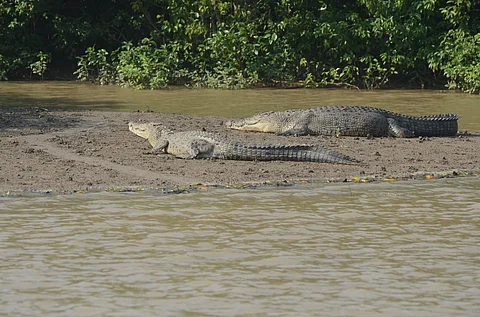

The population of saltwater crocodiles in Odisha’s Bhitarkanika National Park has marginally increased in 2025. Forest officials counted 1,826 crocodiles during the recent annual reptile census whereas in 2024, they sighted 1,811 reptiles.
The enumerators conducted the survey by sighting the crocodiles in various creeks and rivers at both day and night time from January 19-21, Sudarshan Gopinath Yadav, the Divisional Forest Officer (DFO) of the Park, told this reporter.
The survey was conducted under the guidance of Sudhakar Kar, a noted herpetologist.
“During the three-day-long census, we used Timestamp Camera App, the only App that can record video with the time watermark accurate to millisecond (0.001 second) to enumerate the crocodiles. What the app does is record the locations of crocodiles, uses GPS to geotag photo evidence, collects survey information, and reduces human error. The census report also depends on sighting forms by using spotlights to count crocodiles at night,” Kar, a former wildlife researcher with the Odisha forest department, said.
He added that 585 hatchlings (two feet in length), 403 yearlings (two to three feet long), 328 juveniles (three to six feet long), 164 sub-adults (six to eight feet long) and 346 adult reptiles (more than eight feet long) were sighted during the census.
“In 2024, we had sighted 582 hatchlings, 387 yearlings, 327 juveniles, 167 sub-adults and 348 adult reptiles. We also counted 18 albino crocodiles in the water bodies of Bhitarkanika,” Kar, who led the 22 team members in the reptile census noted.
The results of past censuses were:
1,192 (in 2000)
1,330 (in 2001)
1,308 (in 2002)
1,342 (in 2003)
1,355 (in 2004)
1,449 (in 2005)
1,454 (in 2006)
1,482 (in 2007)
1,482 (in 2008)
1,572 (in 2009)
1,610 (in 2010)
1,654 (in 2011)
1,646 (in 2012)
1,649 (in 2013)
1,644 (in 2014)
1,665 (in 2015)
1,671 (in 2016)
1,682 (in 2017)
1,698 (in 2018)
1,742 (in 2019)
1,757 (in 2020)
1,768 (in 2021)
1,784 (in 2022)
1,793 (in 2023)
“The forest department had stopped the crocodile breeding and rearing programme in 2024 in the park as the crocodile population reached a saturation point. But it collects eggs each year from a nest to breed them in the crocodile breeding complex at Dangamal within the park for tourists,” added Kar.
Only adult and sub-adult crocodiles have the capacity to kill human beings. Around 608 crocodiles out of 1,826 in the Park are capable of attacking humans, according to the herpetologist.
“These days, I am worried about the human-crocodile conflict in Bhitarkanika. It is a vast tract of forest and saltwater swamp. We have warned people in many riverside villages not to enter rivers, creeks and other water bodies. Forest officials have also erected barricades around 120 river ghats in the Park and its nearby areas to prevent crocodiles from attacking human beings,” he added.